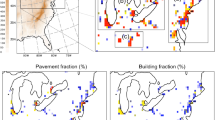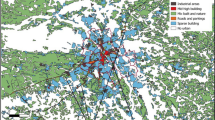Summary
¶A mesoscale analysis of the Urban Heat Island (UHI) of New York City (NYC) is performed using a mesoscale network of weather stations. In all seasons the UHI switches on rapidly in late afternoon and shuts down even more rapidly shortly after dawn. It averages about 4 °C in summer and autumn and 3 °C in winter and spring. It is largest on nights with clear skies, low relative humidity through much of the troposphere, and weak northwest winds, when it may exceed 8 °C. The synoptic meteorological situation associated with the largest UHI occurs roughly two to three nights after cold front passages.
During spring and summer, sea breezes commonly reduce and delay the UHI and displace it about 10 km to the west. Backdoor cold fronts, which occur most frequently in spring and early summer, reduce or even reverse the UHI, as cold air from the water to the northeast keeps NYC colder than the western suburbs. Cases documenting the sensitivity and rapidity of changes of the UHI to changes in parameters such as cloud cover, ceiling, and wind speed and direction are presented.
Similar content being viewed by others
Author information
Authors and Affiliations
Additional information
Received August 16, 2001; revised October 6, 2002; accepted November 20, 2002 Published online March 17, 2003
Rights and permissions
About this article
Cite this article
Gedzelman, S., Austin, S., Cermak, R. et al. Mesoscale aspects of the Urban Heat Island around New York City. Theor. Appl. Climatol. 75, 29–42 (2003). https://doi.org/10.1007/s00704-002-0724-2
Issue Date:
DOI: https://doi.org/10.1007/s00704-002-0724-2




